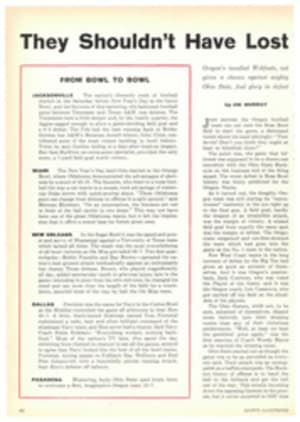
HOT ICE IN THE COLD COUNTRY
Clearly, iceboating is a sport you really have to like. To the average citizen, the idea of climbing into a Thermo suit and going rocketing off across a frozen lake in a needle-slim Skeeter boat like those at the right may seem like an odd thing to do on a frigid January day. However, for 3,000 U.S. iceboaters, most of them concentrated in an area of southern Wisconsin called the Diamond, there is no better way to spend the winter.
Listen to the testimony of Bill Perrigo, a crack racer who lives at Pewaukee Lake, the hottest corner of the iceboating Diamond, bounded by Pewaukee, Lake Geneva, Lake Monona and Lake Winnebago. "Sometimes you feel like you're inside a firecracker with the fuse burning," says Perrigo, describing the thrill of driving an iceboat like his Skeeter Thunderjet at speeds up to 100 mph. "You feel the tensions and strains in your boat, but you're going so fast you hardly notice the speed."
Frank Trost, a Pewaukee neighbor of Perrigo, grows even more lyrical in describing a wild ride in his Tuscarora. "Your boat becomes a thing alive," he says, "and it talks to you. Once, on Delavan Lake, I was on a reach and the wind was hitting in 50-mile puffs. The Tuscarora gave me a hundred-mile-an-hour ride that day. There was no feel at all. Control, but no feel. It was like floating. The wind whistled and screamed in the stays—people on shore said she sounded like a jet—and it was so loud inside my helmet that I couldn't hear the runners."
After that ride Trost's face was bloody from hundreds of tiny cuts sliced into it by flying ice chips. But he ignores such minor discomforts. Like many other iceboat skippers, he refuses to use a protective face mask like the one worn by the crewman at left. He claims a skipper must feel the wind on his face to judge his speed and sense the subtle wind shifts that a skillful sailor can parlay into an extra 10 miles of speed; and that extra speed is worth the cuts and blood that may go with it.
In terms of racing results, this kind of rugged enthusiasm has paid off for sailors like Trost, Perrigo, Skeeter Champion Bill Mattison and Jim Payton, skipper of the roaring, bucking Mary B (left). These four., along with Bud Melges of Lake Geneva, Wis., have at one time or another won every important iceboating trophy in the country. And on the weekend of Jan. 17-19—if the weather is right—these and the other champions from the Diamond will travel to Gull Lake outside Kalamazoo, Mich. to defend their titles in the top event of the year, the Northwestern Ice Yachting Association Annual Regatta. Three weeks later—again if the weather is right—they will go to Lake Geneva for the International Skeeter championships. In all probability, however, the weather will not be right either time. It rarely is, even in Wisconsin.
To get a lake in shape for a race, there must be enough freezing weather to build a layer of ice that will support the likes of the one-ton Mary B. But the temperature must not drop too low. If it goes below 10° Fahrenheit on race day, the race committee is bound by the rules to cancel the regatta. It's simply too cold. On the other hand, the temperature obviously must not climb too high. At 60 mph, a stretch of open water may not do serious damage to either a sailor or his boat. But it can be very embarrassing, and very chilly. What the iceboater prays for is a mild thaw once in a while, even a little rain, to cover up the cracks in the ice, wash away the snow and generally recondition the surface. Then, on race day, the temperature should be about 30°, cold enough for a hard base but warm enough so there is a thin film of oil-slick moisture that lets the runners slide effortlessly over the surface.
Wings of the wind
With ice like this, and a 15-mph wind, a Skeeter racer can, from a standing start, get his 26-foot craft up to 30 mph within 50 yards. With lighter air or slushy ice, the sailor may have to do a lot of running and pushing before he can jump into the cockpit and take a ride from the wind. Once under way on a good day, a Skeeter will average about 40 mph on a windward beat and 65 downwind. The standard iceboat course is up and back; and on those blessed days when the wind is blowing across the course, the Skeeters often average as high as 80 mph, their 75 square feet of sail stretched into an airfoil that pulls them over the frozen lake at anywhere from three to six times the speed of the prevailing wind.
But even on the days when the ice is perfect, iceboating has more than its share of grief. First, there may be a windless day (no race). It may be snowing when the race begins (no visibility). Or overnight the lake surface may have split into nasty pressure ridges (no iceboat). Finally, if everything else is perfect, there is still the chance of running over a beer can or a handful of sand left by an ice fisherman. In a split second, these can take the winning edge from a runner that has been lovingly honed over hours of prerace preparation.
And always the sport has its elements of danger. However, for the dedicated racers who live in the Diamond, the risks and inconveniences are negligible compared to the thrill of a bone-rattling run over perfect ice. "It's the individual challenge," explained Bill Mattison last week as he got ready to travel to Kalamazoo for the Northwestern regatta. "You're all alone. You're just a few inches off the ice. It's quite a sensation. Quite a ride. In fact," he concluded, "there's nothing else like it."
PHOTO
ED STEIN
FACE MASK shields Crewman "Rosie" MacDonald from flying ice. Spiked metal clamps on boots give traction for running starts.
PHOTO
ED STEIN
FLOCKING together near shore of Lake Geneva, dozens of iceboats lie ready and waiting for their races in Northwest Ice Yachting Association meet, world championship for Midwest's 3,000 ice sailors.
PHOTO
ED STEIN
FIGHTING for position at turn marker, Skeeter class boats capable of 100 mph crowd dangerously close as John Bluel Jr. (103) takes the lead over John Bluel Sr. and eventual winner Bill Mattison (left).
PHOTO
ED STEIN
INTO THE AIR goes Mary B, famous world champion Class A iceboat, careening over frozen lake in gusty wind while Skipper Jim Payton (left) and Crew Dave Schmitt of Madison, Wis. fight to keep giant 2,400-pound, $18,000 hull from crashing out of control.
PHOTO
ED STEIN
AUTO-RACING HELMET and goggles protect Dave Rosten, 19, from freezing winds as he tugs on sheet to trim sail of Skeeter.
PHOTO
ED STEIN
SCOTCH-PLAID SKEETER, deck finished in bright tartan pattern, is favorite racing craft for Jean Zwicky of Pewaukee, Wis.
PHOTO
ED STEIN
LEOPARD-SKIN HOOD warms head and ears of Skeeter Racer Chuck Edwards, a mechanical engineer from Lake Pewaukee, Wis.

